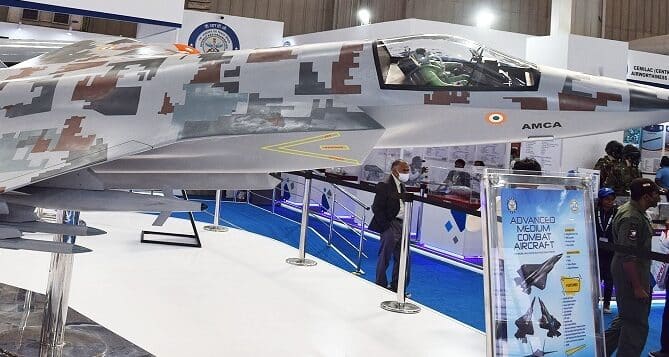Aviation
The AMCA fifth generation fighter made in India will be the most affordable among its competitors?

In an era of rapid technological advances and rising global security issues, India is prepared to change the landscape of aerial warfare with its indigenously developed Advanced Medium Combat Aircraft (AMCA). The AMCA program is a remarkable feat of engineering and creativity that has the prospect of altering the future of military aviation by combining cutting-edge technology with a strategic focus on cost-effectiveness.
The AMCA (Advanced Medium Combat Aircraft) project is an ambitious effort that aims to create cutting-edge fighter aircraft capable of leading modern combat. This aircraft will combine the most recent improvements in vital areas including avionics, stealth technology, sensors, and weapon systems.
While the project admits the incorporation of expensive and sophisticated equipment, which naturally leads to higher prices as compared to its fourth-generation predecessors, there is optimism that these initial costs will stabilize with time. There are also plans for future enhancements, with the MKIII version of the AMCA projected to be completed in 2035.
This cost-effectiveness is supposed to be achieved by a strategic approach that capitalizes on indigenous competencies and resources. According to the AMCA project, around 80% of the aircraft’s components, including its engines, will be manufactured domestically.
Utilizing local production has the ability to lessen reliance on foreign suppliers, which is one of its most important benefits. Long-term cost reductions could result from this decrease in dependency on the outside world. India wants to achieve economic sales, reduce manufacturing costs, and assure the long-term viability of the project by building a strong domestic industrial base for the AMCA.
This strategy offers a variety of advantages. It primarily increases India’s capacity for self-sufficiency and lessens its vulnerability to supply chain interruptions that may result from geopolitical or economic issues. Furthermore, bolstering local manufacturing capacity promotes the development of a skilled labor force, supports technical advancement, and stimulates economic expansion. Additionally, India may position itself as a major player in the global defense market by developing a robust defense industrial base, potentially generating revenue through exports of the AMCA and related technologies.
Most of the technology being developed or adopted in India will make aeroplanes less expensive than other aircraft.
AMCA project represents a forward-looking strategy that prioritizes both cutting-edge technological capabilities and long-term economic sustainability. By focusing on indigenous production and reducing dependence on foreign suppliers, India aims to not only develop a formidable fighter aircraft but also enhance its strategic autonomy and economic resilience on the global stage. This comprehensive approach underscores the intricate interplay between defense, technology, and economic considerations in shaping a nation’s future.

Airlines
Air India to Launch aircraft maintenance training institute in Bengaluru

Air India, one of India’s leading global airlines, is set to establish a Basic Maintenance Training Organization (BMTO) in Bengaluru.
This institute will offer a comprehensive Aircraft Maintenance Engineering (AME) program certified by the Directorate General of Civil Aviation (DGCA). The program will follow an integrated 2+2 year structure, combining classroom learning with practical, hands-on training.
This initiative is part of Air India’s broader goal of creating a robust aviation ecosystem in India. With plans to expand its fleet and strengthen its operations, the airline aims to build a skilled workforce of maintenance engineers, making the organization self-reliant while supporting its ambitious transformation journey.
This country tops visa rejections in the popular Schengen countries
To bring this vision to life, air india has partnered with Bengaluru Airport City Limited (BACL), a subsidiary of Bangalore International Airport Limited (BIAL). Together, they will develop a state-of-the-art facility spanning 86,000 square feet at Bengaluru Airport City.
This purpose-built campus will feature modern classrooms, well-equipped laboratories, and qualified trainers to deliver world-class education and training. The institute is expected to become operational by mid-2026.
The BMTO will be located close to Air India’s new 12-bay Maintenance, Repair, and Overhaul (MRO) facility, also set to open in Bengaluru by early 2026. The AME program will begin with two years of academic coursework, followed by two years of practical training at the MRO, ensuring students receive hands-on experience adhering to industry standards.
Sanctions & Engine Issues Ground Half of Russia’s A320neo fleet
In the meantime, Air India has introduced a Cadet AME program in collaboration with reputable institutions in Bengaluru and Hyderabad.
This ensures continuity in its commitment to developing skilled aircraft maintenance engineers while the BMTO facility is under construction. The program also allows students to pursue a bachelor’s degree through university partnerships, enhancing their career and academic opportunities.
With this initiative, air india plane aims to address the growing demand for skilled professionals in aircraft maintenance and engineering, air india new planes contributing to the development of India’s aviation sector and creating specialized career paths for aspiring engineers.
-

 Aviation2 months ago
Aviation2 months agoMicrosoft Flight Simulator Raises $3 Million to Bring Back the An-225 Mriya
-

 Airlines2 months ago
Airlines2 months agoQatar Citizens Can Travel to the United States Without a Visa
-

 Aviation2 months ago
Aviation2 months agoQatar Airways bans these new Electronic Devices on plane
-

 Airlines2 months ago
Airlines2 months agoJapan Airlines Rolls Out Free Domestic Flights to International Passengers
-

 Defence2 months ago
Defence2 months agoWhich Country Has the Largest Fleet of Fighter Aircraft?
-

 Airport2 months ago
Airport2 months agoWestern Sydney Airport Welcomes Its First Plane After 6 Years of construction
-

 Travel2 months ago
Travel2 months agoQatar Airways Launches Four Additional Flights from Amsterdam
-

 Aviation2 months ago
Aviation2 months agoDid you know ? Once Boeing 747 carried 1088 passenger in 1991








